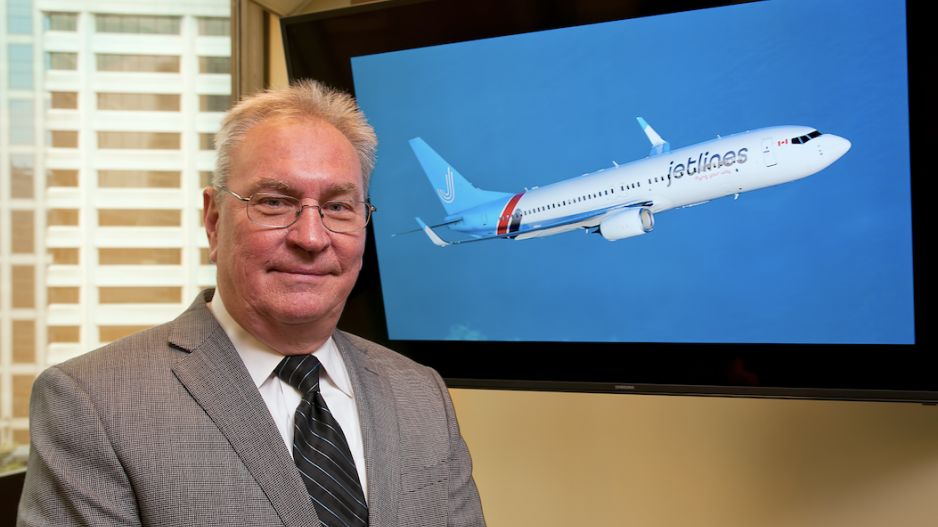Metro Vancouverites are likely to have several options when choosing an ultra-low-cost carrier in July 2018, when WestJet Airlines Ltd. (TSX:WJA) subsidiary Swoop and Canada Jetlines Ltd. (TSX-V:JET) plan to launch flights.
How different the two airlines will be from each other remains to be seen, but their operations are expected to be similar to those of Flair Airlines, which also bills itself as an ultra-low-cost carrier (ULCC) and plans to expand its route network to seven cities, including Vancouver International Airport, in December.
Jetlines and Swoop had been expected to fly out of Vancouver International Airport, but Jetlines is finalizing a contract with Abbotsford International Airport that would enable the carrier to use that airport when it launches flights.
Swoop has hinted that it might follow suit, but its executive vice-president of strategy, Bob Cummings, told Business in Vancouver that he would not reveal Swoop’s flight plan until February.
Vancouver International Airport includes a $5 AIF on all tickets for passengers who fly out of the airport to B.C. destinations, and a $20 AIF on all tickets for passengers who fly outside the province.
“We’re planning on serving Abbotsford International Airport,” Jetlines president Stan Gadek told BIV.
“It fits our profile, which is to be low-cost. To get low costs, we need to look at all of our input costs, including airport costs, and Abbotsford has no airport improvement fee [AIF].”
Beyond the base fare, ULCCs typically charge for an array of extras ranging from using a credit card to book a flight to advance seat selection.
Jetlines plans to follow Flair’s lead by charging passengers a fee for each piece of luggage and higher fees for all bags stowed in the cabin because the airlines want to load and unload its planes as fast as possible.
WestJet’s main operation charges an average of about $19 per passenger in ancillary fees. The airline’s CEO, Gregg Saretsky, told media October 31 that he expects ancillary fees at Swoop to be double that.
Carl Jones, Vancouver Airport Authority’s director of air service development, said he hopes that in time Jetlines will also have flights out of Vancouver International Airport.
While Abbotsford has the cost advantage of no airport improvement fee, it’s not serviced by the same kind of public rail line that links downtown Vancouver with the airport in Richmond.
Abbotsford International Airport general manager Parm Sidhu told BIV that his airport’s decision to eliminate its AIF earlier this year shows how determined he is to make the airport attractive for carriers.
“We’re an ultra-low-cost airport, and we have a cost structure that makes us an outlier,” he said.
While landing and terminal fees vary, Sidhu said an airline could service a Boeing 737 on a domestic flight out of Abbotsford for less than $550.
Jones would not estimate how much that would cost at Vancouver International Airport, but Sidhu and Gadek agreed the cost would be much more.
While the relatively deep-pocketed WestJet readies to launch Swoop, Jetlines has been holding investor presentations to try to attract capital for its operations, which will be run initially with two leased Boeing 737-800 planes. Operations will then ramp up to 12 planes within two years, Gadek said.
He said the company plans to launch with just two planes because Transport Canada has a financial stress test that it applies to all new airlines.
Operators who launch airlines must have cash, or access to cash through lines of credit, equal to 90 days of operating expenses, assuming no revenue at all, he said. So if the airline had more planes at the start, Transport Canada would require that it be more heavily capitalized.
Gadek said he expects Jetlines to have 24 leased planes within five years.
Swoop, meanwhile, also intends to launch with two Boeing 737-800s. It will then ramp up to six planes by September and have 10 planes by the summer of 2019, according to plans released by WestJet.
Flair announced November 2 that it obtained private financing enabling it to acquire two new Boeing 737-400 planes, bringing its total plane count to seven.
If Jetlines and Swoop launch operations as planned, Gadek’s number crunching suggests both could be successful because they will:
•take business from established domestic carriers;
•add business from passengers who stop crossing the border to the U.S. for cheap flights; and
•encourage people to fly who otherwise would stay home.
Cummings disagrees.
“We believe Canada can only support one major ULCC with its population and land mass, and we know that Swoop will be it,” he said. “WestJet is best suited to start a ULCC in Canada because [of] its parent’s health, in particular its exceptionally strong balance sheet.” •




